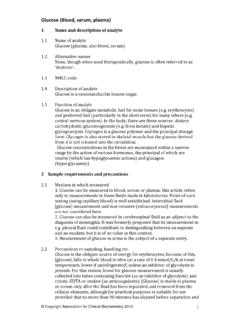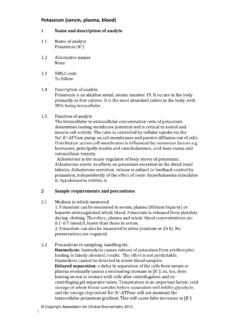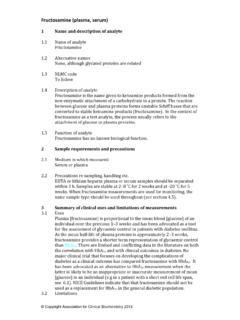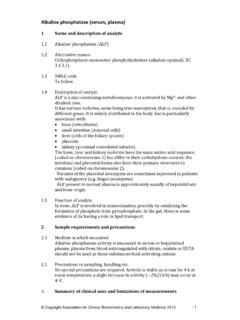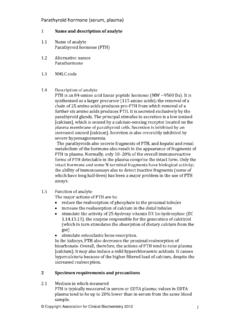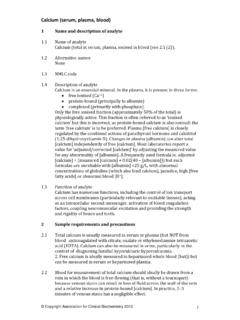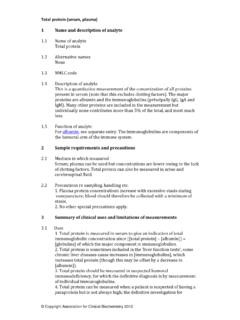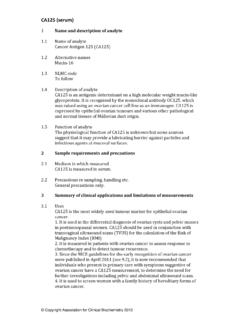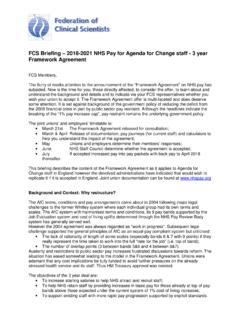Transcription of Procalcitonin (serum, plasma) - Association for …
1 Procalcitonin ( serum , plasma ) 1 Name and description of analyte Name of analyte Procalcitonin (PCT) Alternative names None NLMC code To follow Description of analyte Procalcitonin (PCT) is a 116 amino acid precursor to calcitonin. In normal metabolic conditions, calcitonin is produced solely by the C cells of the thyroid medulla and neuroendocrine cells in the lungs. Functions of analyte Following proinflammatory stimulation (particularly systemic bacterial infection), PCT is produced by numerous cell types. PCT affects the immune response by modulating the induction of proinflammatory cytokines.
2 It also acts as a chemokine, influencing the migration of monocytes and parenchymal cells to the site of inflammation. PCT plays a role in vascular contraction through inhibiting or activating the induction of inducible NO synthase (iNOS). 2 Sample requirements and precautions Medium in which measured serum , heparinised plasma and K+ EDTA plasma Precautions re sampling, handling etc. Where possible, samples for PCT analysis should be separated and analysed within four hours of the blood draw. Samples can be stored at 2 . 8 C for up to 24 h; and samples should be frozen at 20 C within 48 h. A single freeze thaw cycle may lead to a reduction in recovery of up to 8%.
3 All samples should be centrifuged prior to analysis to ensure they are free of fibrin or other particulate matter. 3 Summary of clinical uses and limitations of measurements Uses 1. Diagnosis of bacterial lower respiratory tract infections (LRTIs) and sepsis 2. Monitoring the progression of sepsis and its response to treatment 3. Informing the initiation, a change in or the cessation of antimicrobial treatment for bacterial sepsis Copyright Association for Clinical Biochemistry 2013. Limitations Whilst PCT exhibits a degree of specificity for bacterial infection, sepsis, severe sepsis and septic shock as the [PCT] seen in such conditions can be extremely high (>10 ng/mL), [PCT] can be raised as a result of other pro.
4 Inflammatory stimuli such as surgery, trauma, severe viral infections and fungal infections. It is therefore essential to use all available clinical information when interpreting the results of a PCT measurement. 4 Analytical considerations Analytical methods All methods for the quantification of PCT are based on immunoassay. The time taken from assay start to the generation of a result varies from 18 minutes to h according to the assay used. The original PCT assay was developed as a luminometric immunoassay (LIA) using a coated tube system with two monoclonal antibodies and a luminometric tracer.
5 Based on this, a number of automated assays have been developed using TRACE (time resolved amplified cryptate emission), ELFA (enzyme linked fluorescent assay), CLIA (chemiluminescent immunoassay) and ECLIA (electrochemiluminescent immunoassay) technologies for use on the automated platforms BRAHMS Kryptor , BioM rieux VIDAS , Siemens Advia Centaur and Roche Elecsys respectively. A semi quantitative point of care test, PCT Q, incorporating an immunochromatographic assay using immunogold labelling is also available. Quantitation is based on comparing the intensity of colour development after 30 minutes to a chart provided by the manufacturer.
6 The strength of colour development can be interpreted as >2 ng/mL or >10 ng/mL. Reference method There is currently no agreed reference method for Procalcitonin . However, all automated and PoCT assays have been developed to, the results compared with, and the published reference ranges have been determined by, the LIA method. Reference materials No reference material is currently available. Interfering substances Haemolysis, icterus and lipaemia do not interfere with the measurement of PCT unless gross. Sources of error The presence of fibrin or other particulate matter in the sample can lead to falsely low results.
7 The high dose hook effect is a possibility at very high [PCT]. 5 Reference intervals and variance Reference interval (adults) Healthy individuals: ng/mL Copyright Association for Clinical Biochemistry 2013. Diagnosis of lower respiratory tract infections: Absence of infection: PCT < ng/mL Bacterial infection unlikely: PCT < ng/mL Bacterial infection possible: PCT < ng/mL Suggestive of bacterial infection: PCT ng/mL Diagnosis of systemic bacterial infection or generalised sepsis: Systemic infection unlikely: PCT < ng/mL Systemic infection possible: PCT < 2 ng/mL Systemic infection likely: PCT 2 ng/mL Severe sepsis or septic shock likely: PCT 10 ng/mL Reference intervals (others) The cut off values described in section are generally also applicable to a paediatric population.
8 However, variations in cut off concentrations have been published, particularly for ruling in/out bacterial meningitis. Extent of variation (Barassi A, Pallotti F, Melzi d'Eril GV. Clin Chem 2005; 50:1878) Interindividual CV: 22% in healthy individuals Intraindividual CV: 16% in healthy individuals Index of individuality: CV of method Typically < 10% Critical difference (if assay CV 15%) Sources of variation plasma [PCT] is affected by the presence of inflammation, most significantly in response to bacterial infection. However, plasma [PCT] may be raised in patients with medullary thyroid carcinoma.
9 6 Clinical uses of measurement and interpretation of results Uses and interpretation 1. PCT can be indicated in the diagnosis of bacterial infection (in particular lower respiratory tract infections) and sepsis, to assist in determining whether antimicrobial treatment should be commenced. This is most frequently done in the emergency department, but PCT can also be used to diagnose nosocomial infections such as hospital acquired pneumonia. 2. PCT can be used to guide antimicrobial treatment with particular relation to continuing, changing or ceasing antimicrobial agents, most frequently in the critical care environment.
10 3. PCT can be used in the diagnosis of neonatal sepsis, although care should be taken when interpreting results as [PCT] may be > 10ng/mL in neonates in the absence of infection. Confounding factors plasma [PCT] can be raised from non bacterial causes such as surgery (particularly abdominal surgery), trauma, severe pancreatitis, severe liver damage, severe multi organ dysfunction syndrome, severe burns and severe fungal infections. 7 Causes of abnormal results High values Copyright Association for Clinical Biochemistry 2013. Causes Bacterial infection Sepsis Trauma Surgery (in particular abdominal surgery) Severe multi organ dysfunction syndrome Severe pancreatitis Severe liver damage Severe burns Severe fungal infections First days of life in neonates.

